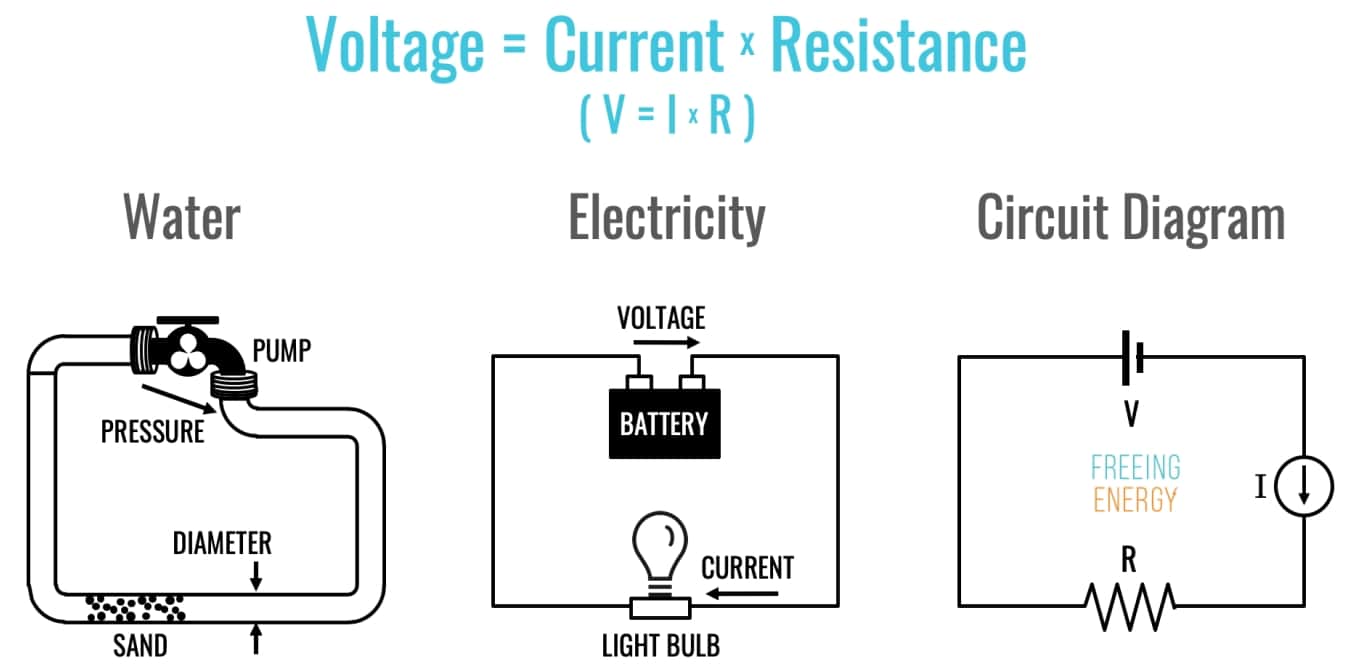Let’s learn about electricity. This post gives you an introduction to this topic, with many Electricity Learning and Education Documents available further below. Electricity is the flow of electric charges, usually through a conductor such as a wire. Electrons, which live in the outer shells of atoms, are electrically charged particles that carry these charges. The movement of these charges is called an electric current. This flow of electrons creates an electric current, which is why we say electricity is “electrically charged”. The type of material through which the current flows determines whether or not it will conduct electricity. Metals (such as copper) conduct electricity well because they have free electrons that can move easily across their surface; nonmetals (like plastics) do not conduct electricity well because their atoms are tightly bound together and their electrons are tightly bound to them.
Electric current is the flow of electric charges through a conductor per unit of time and is usually measured in amperes (amps). The quantity of electrons flowing through the conductor per unit of time, such as an hour (Amp-hour or Ah), determines the size of the electric current, or amps. The flow of electrons determines the direction of the current flow.
Voltage, also known as electric potential difference or electromotive force, is a measure of the potential energy per unit of charge in an electrical circuit. It is the force that drives the flow of electric current through a circuit and is measured in units of volts (V). The energy source—such as a battery or a generator—determines the voltage applied to a circuit.
An electric circuit is a closed loop of conductive material through which electric charges can flow. In a circuit, electric current flows from a source of voltage (such as a battery or generator) through a conductor to a load (such as a light bulb or motor), and then back to the source of voltage.
Resistance is a measure of how difficult it is for electric charges to flow through a conductor. The material and shape of the conductor determine the measurement, which is typically in ohms (Ω). In an electrical circuit, the resistance of the conductor can oppose the flow of electric current and cause a voltage drop across the conductor.
Direct current (DC) and alternating current (AC) are the two forms of electric current (DC). An electric current called an AC current often flips direction. Most houses and businesses utilize this kind of current, which is provided by utility providers. Alternating current, which generators produce, is easily converted to various voltages for long-distance transmission. The frequency at which AC voltage and current fluctuate varies by area but is commonly 50 or 60 Hertz (Hz).
A direct current (DC) is an electric current that flows only in one direction. It is widely used in batteries, solar cells, and a variety of electronic devices. DC current is more efficient for long-distance transmission over 300 miles because it is easier to control and distribute than AC current.
Watts (W) are a unit of measurement for power, which is the rate at which energy is used, transferred or converted. Power is usually measured in watts and is a measure of how quickly energy is used or produced. Power in an electrical circuit is equal to the circuit’s applied voltage times the current flowing through it.
How do Amperes work?
The flow of electrons across a conductor, known as electric current, is measured in Amperes (also spelled “amps“). In a circuit, which is a closed loop of conductive material through which electricity may flow, electric current is frequently measured. The amount of electric current depends on how many electrons pass through the conductor in a certain amount of time. The ampere, a unit of measurement for electric current, is relevant in this situation. A coulomb, which is a measure of electric charge, is equivalent to one amp.
The resistance of a conductor and the voltage applied to it determine the amount of electric current that flows through it. This relationship is described by Ohm’s Law, which states that the current (I) flowing through a conductor is equal to the voltage (V) applied across it divided by the resistance (R) of the conductor:
I = V/R
In other words, the higher the voltage applied to the conductor, the greater the electric current that flows through it. Similarly, the lower the resistance of a conductor, the greater the electric current that flows through it.
Electric current is a critical parameter in the area of electrical engineering since it is used to calculate the power of an electrical circuit and the size of components required to properly manage the current. It’s also used to figure out how much energy is transported or consumed in an electrical system.
How do Volts work?
Voltage (V) is a measure of the potential energy per unit of charge in an electrical circuit. It is also known as electric potential difference or electromotive force. It is the force that causes electric current to flow through a circuit and is measured in volts (V).
As in a fluid system, voltage is the electrical equivalent of pressure. Electric charges flow from an area of high voltage to an area of low voltage in the same way that water flows from an area of high pressure to an area of low pressure. Voltage drop is the voltage difference between two points in a circuit.
The energy source—such as a battery or a generator—determines the voltage applied to a circuit. In a simple circuit, the voltage is equal to the energy required to move a unit of electric charge between two points in the circuit. If you had two circuits with different resistances but the same voltage applied across each one, they would both have the same amount of power flowing through them because they’re receiving the same amount of energy from the battery source; however, one circuit might be less effective at using that stored energy than another because its resistance is lower and thus more “efficient.”
Voltage is an important parameter in electrical engineering because engineers use it to calculate the efficiency of electrical circuits and the size of the components they require to manage voltage safely. Voltage is also used to determine the amount of power being utilized or transferred by an electrical system.
How do Watts work?
Watts (W) are a unit of measurement for power, which is the rate at which energy is used, transferred or converted. Power is usually measured in watts and is a measure of how quickly energy is used or produced.
Calculating power in an electrical circuit involves multiplying the circuit’s applied voltage by the current that is flowing through it. This is the equation to determine the amount of power:
Power (P) = Voltage (V) x Current (I)
In other words, as the voltage supplied to the circuit or the electric current running through it grows, so does its power. For instance, a circuit with a 220 volt power supply and a 10 amp fuse can handle up to 2200 watts of electricity.
Power is an important measure in the field of electrical engineering, as it is used to calculate the amount of energy being used or produced in an electrical system, as well as to determine the size and capacity of electrical components and systems.
Electricity Learning and Education Documents
(all files in pdf format)
Learning about Basic Electricity for All Grades
- Understanding Basic Electrical Theory
- Voltage and Current
- Electricity and Circuits
- Circuits and Electricity
- Simple Series Circuits
- Drawing Circuits Lesson, Grades 4-8
- Basic Electricity Worksheet
- Understanding The Basics Of Electricity By Thinking Of It As Water
- Electrical Circuits Activity Book
- Electricity Slides, lower grades -1
- Electricity Slides, lower grades -2
- Electricity from Energy Kids Place
- What Is Electricity Lesson
Learning about Electricity for Upper-level Grades
- Introduction to Electrical Theory
- Basic Principles of Electricity, upper grades presentation
- Teach Yourself Electronics, upper grades
- Fundamentals of Electricity, upper grades
- Basics of Electricity Course by Siemens
- Basic Electronics Student Handbook
- Basics of Electricity
- Current Electricity
- Introduction to Electricity from New York University
- Basics of Electricity Slides
- Electricity Slides, upper grades -1
- Electricity Slides, upper grades -2
- Basic Electricity and Magnetism Electricity
- Electricity BSA Merit Badge
- Electricity in the Home
- Household Electricity
- Fields and Circuits Textbook (Answer key)
For more electricity and similar educational materials, please see these posts: 4th Grade Physical Science Course: Magnetism and Electricity, Over 200 Physics and Engineering Activities, Lessons, and Units and Physical Science For Middle School Text with Workbook & Teacher Edition,
-love learning -your best ed lessons guide, Scott




